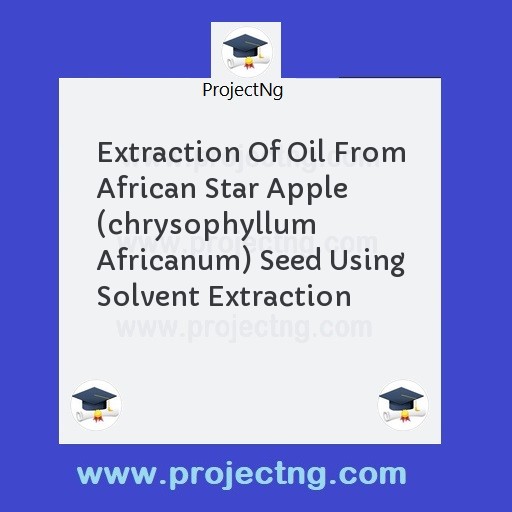Extraction Of Oil From African Star Apple (chrysophyllum Africanum) Seed Using Solvent Extraction
Science Lab Technology Project Topics
Get the Complete Project Materials Now! »
EXTRACTION OF OIL FROM AFRICAN STAR APPLE (CHRYSOPHYLLUM AFRICANUM) SEED USING SOLVENT EXTRACTION
ABSTRACT
Oil is extracted from locally purchased African Star apple using Sochlet extractor. Knowledge and information regarding the elemental composition of the fruits are very essential both to the human nutritionist and the horticulturist since minerals play vital roles in the life of both the human being and plants.
TABLE OF CONTENTS
Title page
Certification
Dedication
Acknowledgement
Abstract
Table of contents
CHAPTER ONE
1.1 Introduction
1.2 Aims and Objectives
1.3 Statement of Problem
1.4 Significance of the Study
1.5 Limitation of Study
CHAPTER TWO
2.1 Literature Review
2.2 Land Use
2.3 Propagation Techniques/Planting
2.4 Storage Techniques
2.5 Method of Extraction of Oil
CHAPTER THREE
3.1 Methodology
CHAPTER FOUR
4.1 Results
CHAPTER FIVE
5.0 SUMMARY, CONCLUSION AND RECOMMENDATION
5.1 Summary
5.2 Conclusion
5.3 Recommendation
REFERENCES
CHAPTER ONE
1.1 INTRODUCTION
The African Star Apple (Chrysophyllum Africanum), locally called “Udala” by the Ibos and “Agbalumo” by the Yorubas is found mostly in African Countries. Its distribution extend from Sierra Leone to the Congo region and Angola, found in rain forest and transitional formations, often planted for its edible fruits. Its distribution also extends to Sierra Leone to Spain, Guinea, extending to Sudan, Uganda, Kenya and Nyasaiano. It is also found in countries like Southern Nigeria, Cameroons, Ghana, Ivory Coast and Sierra Leone. Chrysophyllum Africanum is of the family “Sapotacea”. Its habitat is usually on riverside in closed forest, and often planted in villages. Chrysophyllum Africanum has different species, but Chrysophyllum Africamum and Chrysophyllum Albidum bear the same common name in Nigeria “UDALA”. (Okafor 1981).
A medium sized, evergreen three usually 70ft to 100ft high; bole straight, flitted, bark gray and riddget, slash thin, cale brown, darkening to orange, Heartwood whitish when first felled, turning a pink buff to an olive yellow and finally a yellowish brown, not demarcated from the sapwood.
Texture fine to medium, grain straight to occasionally interlocked, luster rather low; wood contains a pale brown gum. Chrysophyllum africanum bears edible fruits with large berries containing five large flattened seeds. It is greenish in colour when unripe and pale orange when ripe. It is pointed at both ends. The fruits are large and more than 4cm wide, shaped like orange or apple, it is often cultivated for its edible fruits and the pulp having a pleasant acid taste (Nwadinigwe, 1982).
Chrysophyllum africanum (African Star apple propagation is by seed either by encouraging natural regeneration or plantation traditionally. The sapwood is pale yellow and takes a good polish. It is fine grained, hard and tough polishes well.
It is used in carving and tourney. The seeds yield edible oil, which is sometimes used in Ashanti for making soap. The latex is used as birdlime, the
Be the First to Share On Social

Enjoying our content?
Don't miss out on new videos! Subscribe to our YouTube channel for more awesome content.
Subscribe Now!













